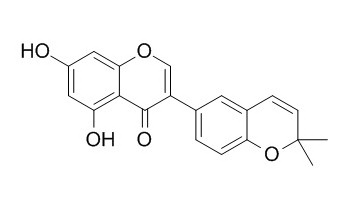Isoderrone
Isoderrone shows inhibitory effects on α-glucosidase in vitro; it is a protein tyrosine phosphatase 1B (PTP1B) inhibitor, with IC50 value of 22.7 ± 1.7 uM, suggests that it may be a new drug for treatment of type 2 diabetes.
Inquire / Order:
manager@chemfaces.com
Technical Inquiries:
service@chemfaces.com
Tel:
+86-27-84237783
Fax:
+86-27-84254680
Address:
1 Building, No. 83, CheCheng Rd., Wuhan Economic and Technological Development Zone, Wuhan, Hubei 430056, PRC
Providing storage is as stated on the product vial and the vial is kept tightly sealed, the product can be stored for up to
24 months(2-8C).
Wherever possible, you should prepare and use solutions on the same day. However, if you need to make up stock solutions in advance, we recommend that you store the solution as aliquots in tightly sealed vials at -20C. Generally, these will be useable for up to two weeks. Before use, and prior to opening the vial we recommend that you allow your product to equilibrate to room temperature for at least 1 hour.
Need more advice on solubility, usage and handling? Please email to: service@chemfaces.com
The packaging of the product may have turned upside down during transportation, resulting in the natural compounds adhering to the neck or cap of the vial. take the vial out of its packaging and gently shake to let the compounds fall to the bottom of the vial. for liquid products, centrifuge at 200-500 RPM to gather the liquid at the bottom of the vial. try to avoid loss or contamination during handling.
Food Funct.2024, 15(8):4262-4275.
Brain Res Bull.2024, 218:111103.
Molecules.2021, 26(4):1084.
Food Sci Biotechnol.2024, 33(15):3629-3637.
J Agric Food Chem.2024, acs.jafc.4c01387.
Front Pharmacol.2020, 11:683.
Korean Herb. Med. Inf.2021, 9(2):231-239.
Int Immunopharmacol.2022, 106:108603.
J Ethnopharmacol.2019, 244:112074
Int J Mol Sci.2023, 24(22):16465.
Related and Featured Products
Chem Biodivers. 2016 Apr;13(4):445-50.
New Alkaloids and α-Glucosidase Inhibitory Flavonoids from Ficus hispida.[Pubmed:
27002475 ]
METHODS AND RESULTS:
Two new pyrrolidine alkaloids, ficushispimines A (1) and B (2), a new ω-(dimethylamino)caprophenone alkaloid, ficushispimine C (3), and a new indolizidine alkaloid, ficushispidine (4), together with the known alkaloid 5 and 11 known isoprenylated flavonoids 6 - 16, were isolated from the twigs of Ficus hispida. Their structures were elucidated by spectroscopic methods.
CONCLUSIONS:
Isoderrone (8), 3'-(3-methylbut-2-en-1-yl)biochanin A (11), myrsininone A (12), ficusin A (13), and 4',5,7-trihydroxy-6-[(1R*,6R*)-3-methyl-6-(1-methylethenyl)cyclohex-2-en-1-yl]isoflavone (14) showed inhibitory effects on α-glucosidase in vitro.
Molecules. 2017 Jul 20;22(7).
High-Resolution Inhibition Profiling Combined with HPLC-HRMS-SPE-NMR for Identification of PTP1B Inhibitors from Vietnamese Plants.[Pubmed:
28726759 ]
Protein tyrosine phosphatase 1B (PTP1B) plays a key role as a negative regulator in insulin signal transduction by deactivating the insulin receptor. Thus, PTP1B inhibition has emerged as a potential therapeutic strategy for curing insulin resistance.
METHODS AND RESULTS:
In this study, 40 extracts from 18 different plant species were investigated for PTP1B inhibitory activity in vitro. The most promising one, the EtOAc extract of Ficus racemosa, was investigated by high-resolution PTP1B inhibition profiling combined with HPLC-HRMS-SPE-NMR analysis. This led to the identification of Isoderrone (1), derrone (2), alpinumisoflavone (3) and mucusisoflavone B (4) as PTP1B inhibitors. IC50 of these compounds were 22.7 ± 1.7, 12.6 ± 1.6, 21.2 ± 3.8 and 2.5 ± 0.2 μM, respectively. Kinetics analysis revealed that these compounds inhibited PTP1B non-competitively with Ki values of 21.3 ± 2.8, 7.9 ± 1.9, 14.3 ± 2.0, and 3.0 ± 0.5 μM, respectively.
CONCLUSIONS:
These findings support the important role of F. racemosa as a novel source of new drugs and/or as a herbal remedy for treatment of type 2 diabetes.
J Nat Prod. 2002 Mar;65(3):403-6.
Prenylated isoflavonoids from the root bark of Erythrina vogelii.[Pubmed:
11908991]
METHODS AND RESULTS:
Four new prenylated isoflavonoids, vogelins D-G (1-4), were isolated from the CH2Cl2 extract of Erythrina vogelii root bark in addition to the known compounds isolupalbigenin (5), ficuisoflavone (6), ulexone (7), isochandalon (8), and Isoderrone (9). The structures 1-4 were elucidated by spectroscopic and chemical methods.
CONCLUSIONS:
The absolute configuration of compound 1 was determined on the basis of its CD spectrum. Possible biogenetic relationships among the E. vogelii isoflavonoids are briefly discussed.



